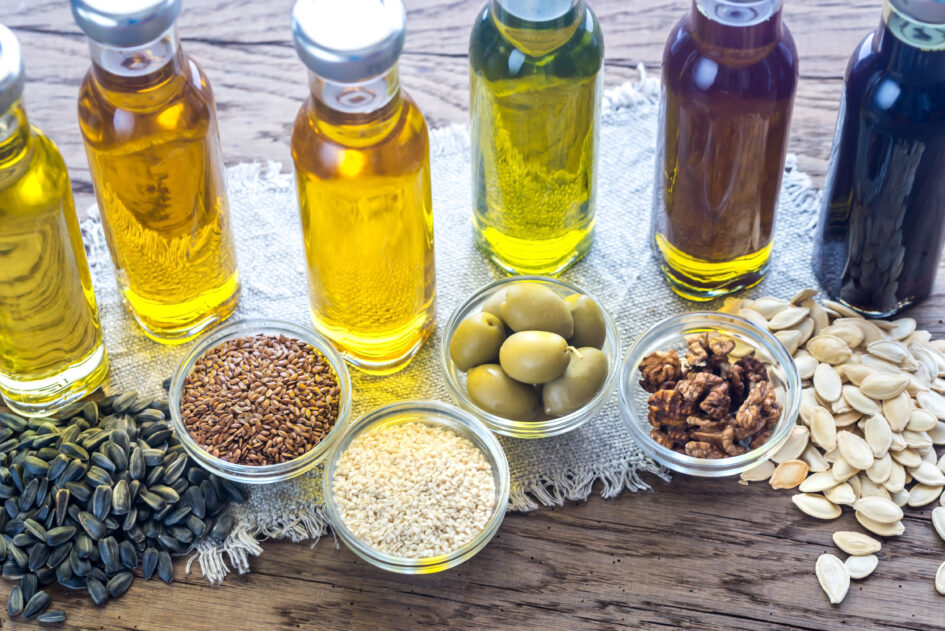Discover the Healthiest Oils to Cook With and How to Use Them Correctly!
With several cooking oils available at the grocery store, it’s sometimes hard to know what type to use and when. Read on for a guide on how to choose not only healthy cooking oils, but also the best choice for specific cooking methods.
Do you get confused when it comes to cooking oils? With a plethora of options, knowing what type of oil to use for a specific recipe or cooking style can be overwhelming. However, it’s important to know that there is quite the difference between oils, especially pertaining to their nutritional value and appropriate uses.
Oils all have some combination of saturated, monounsaturated and polyunsaturated fats, and are high in calories, however, the type of fat in individual oils varies dramatically (see the chart below for the percentages of different fats in common cooking oils).
Another difference among oils is their smoke point. The smoke point is the temperature in which the oil starts to break down. If an oil starts smoking, discard the oil since it loses some nutritional value and can result in an unpleasant bitter taste.
Review the following oils to learn how to choose the appropriate oil the next time you want to sauté, bake or stir fry.
- Extra Virgin Olive Oil
- Olive oils are graded by quality with extra virgin olive oil being the highest quality and containing beta carotene, vitamins A, E, D and K. Other versions are processed, such as “light” olive oil, which means light in flavor, not calories, and does not have the same nutritional value as extra virgin olive oil.
- Uses: sautéing, dips and salad dressings
- Canola Oil
- It’s low in saturated fat and high in mono- and polyunsaturated fats, including omega-3 fats.
- Uses: It’s good for sautéing, stir frying and baking.
- Vegetable Oil
- It’s often soybean or a blend of soybean with other oils, mostly polyunsaturated fats.
- Uses: It’s all purpose since it has a neutral flavor and a high smoke point, and is good for baking and sautéing.
- Avocado Oil
- It is high in monosaturated fat and has a nutty and buttery flavor.
- Uses: It has a high smoke point, so it’s ideal for sautéing or frying.
- Peanut Oil
- It’s high in monounsaturated fat.
- Uses: It has a high smoke point, so it’s good for stir frying or frying.
- Sesame Oil
- It includes about equal amounts of mono- and polyunsaturated fats along with vitamin K.
- Uses: It has a high smoke point and can be used in a variety of cooking methods, has a nutty flavor, and it’s often used in Indian, Middle Eastern, African and Southeast Asian dishes.
- Flaxseed Oil
- It’s high in omega-3 fats.
- Uses: It has a low smoke point, so is best used to make salad dressing, but please note that it spoils very quickly (within five weeks of harvest).
You will notice a few oils listed that are good for frying due to a high smoke point. Keep in mind that frying foods should be done in limited amounts since no matter how healthy the oil is, it’s still calorie dense.
You’ve likely heard of or have used other oils, such coconut oil, and read about its potential health benefits. Although research is still ongoing, coconut oil is high in saturated fat and has been shown to increase LDL and HDL cholesterol.
When it comes to fat found in food, the 2015-2020 Dietary Guidelines for Americans recommend limiting saturated fat intake to less than 10 percent of your total calorie intake and rather choosing foods with monounsaturated and polyunsaturated fats.
Regardless of the type of oil you choose, be mindful that all oils are calorie dense, therefore, you should use them in moderation along with a well-balanced diet.
Sources:
“Healthy Cooking Oils,” heart.org, accessed Dec. 8, 2020.
“Which type of oil should I use for cooking with high heat?” mayoclinic.org, accessed Dec. 8, 2020.
“All About Oils,” foodandnutrition.org, accessed Dec. 8, 2020.
“Heart-Healthy Oils: They’re Not All Created Equal,” todaysdietitian.com, accessed Dec. 9, 2020.

